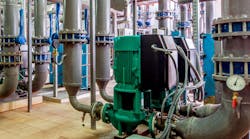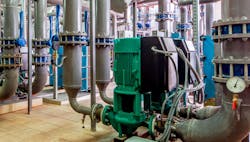How ultrasonic flow meter technology helps drive energy efficiency
Industrial energy efficiency has improved dramatically in recent decades. Even so, a large portion of global energy demand still goes towards manufacturing operations. The high level of energy that industrial plants consume has a major impact on both the economy and the environment.
For today’s industrial organizations, maintaining sustainable operations has become a key requirement. With the green energy movement gaining momentum, manufacturing facilities are seeking to become more energy-efficient. One of the highest priorities is effective energy management. Plant managers have the challenging task of managing all the flow energy in their facility. They and their facility operators and MRO teams need proven technologies to monitor the consumption of energy in a wide range of applications.
Many industrial sites can significantly improve their operating efficiency, and apply industry-accepted energy management strategies, by deploying advanced flow measurement technology. The latest ultrasonic flow meter solutions enable plants to obtain the information needed to meet their sustainability goals, reduce energy costs, and improve overall performance.
Typical measurement requirements
Plant MRO departments must find ways to better monitor crucial energy-related factors, such combustion air and fuel gas flow, to identify loses and improve profitability. By monitoring the end-use locations of fuel across the plant and measuring the consumption rate for individual applications, plant personnel can gain insight into potential areas of efficiency optimization. This is also the situation with electricity consumption. In both cases, reductions in energy usage can be achieved simply by determining where resource losses are taking place.
When it comes to boiler operation, for example, the combustion efficiency of air and fuel mixtures is a critical concern. Too much oxygen reduces the operating efficiency of the boiler and causes undesirable pollutants. Likewise, too little oxygen results in fuel not completely combusting and can create a build-up of soot that clogs surfaces and reduces boiler efficiency.
Comparing the flow of natural gas, propane, and other fuel gases to combustion sources versus the output of steam and hot water by those assets can help in driving operating efficiency initiatives. Evaluating equipment performance based on accurate flow data may also assist with plant optimization strategies. Reductions in fuel usage are one of the simplest ways to lower operating expenses (OPEX) and increase profits.
Deploying a metering technology
Whether industrial organizations are trying to meet strict energy consumption requirements and comply with greenhouse gas (GHG) standards, or are looking to apply industry best practices to optimize processes, they can utilize advanced measurement technologies to provide the information needed to meet energy efficiency goals, save money and improve plant performance.
In applications where measurement of hot water and heating liquids is required, such as measuring boiler output to determine if the equipment is operating efficiently, plant personnel can deploy a flow meter with integrated temperature measurement to measure both supply and return temperature and then calculate thermal energy in BTUs. The temperature measurement is typically achieved via use of precision resistance temperature detectors (RTDs), while the liquid flow rate measurement can be performed by an electromagnetic flowmeter, a turbine flowmeter, an ultrasonic flowmeter, or a variety of other flow measurement technologies.
In recent years, ultrasonic flow meters have become a common choice for engineers, operators and maintenance technicians concerned with managing energy at their facilities. These devices employ a proven, non-invasive measuring technique, which involves no moving or wetted parts, and results in no pressure loss. The flow sensors are applied using standard silicone for long-term connectivity to the piping. The ultrasonic meter design offers a wide turndown ratio and provides maintenance-free operation—all of which are important advantages over conventional mechanical and digital meters.
Transit time ultrasonic flow meters, in particular, are well suited for thermal measurements in thermal energy monitoring applications. With this clamp-on style meter, an ultrasonic signal is transmitted in the direction of the flowing fluid downstream, and then another signal is transmitted against the flowing fluid upstream. The time for the sonic pulse to travel downstream is compared to the time for the pulse to travel upstream. This differential time is used to determine the velocity of the flowing fluid, and then calculate the volumetric flow rate in the pipe.
With a matched pair of RTD temperature sensor probes, transit time ultrasonic flow meters can measure the thermal energy (BTU) using the temperature of the supply and return lines of a heating or cooling circuit. These meters typically provide input and output interfaces, batch control and alarm and flow/energy totalizing, which can be employed by a host computer, Burner Management System (BMS), PLC, or flow controller for monitoring and control purposes.
A solution combining a clamp-on, transit time ultrasonic flow meter with precision RTDs provides a cost-effective way of measuring volumetric flow and obtaining energy readings to evaluate the efficiency of boiler and chiller operations, among other plant equipment. By measuring the flow and differential temperature (ΔT), users can calculate the energy consumed in BTUs. Equipment efficiencies can then be calculated as a baseline, and ongoing performance can be continuously monitored.
With a clamp-on ultrasonic flow meter, there is no need to cut piping for installation, no hot permits are required for field welding, and the device provides high accuracy for most flow and BTU energy measurement applications. Such meters also offer an extremely wide turndown and provide maintenance-free operation.
Conclusion
Monitoring energy consumption in industrial equipment applications is critical to improving plant operating efficiency, identifying the waste of resources and minimizing greenhouse gases going into the atmosphere. Modern flow meter technologies like transit time ultrasonic meters provide accurate flow energy measurements that make it possible to meet corporate energy management objectives while supporting today’s green energy initiatives.
Plant managers, operators, engineers and maintenance and reliability professionals should consider all the relevant application factors (e.g., fluid type, flow rate, accuracy and turndown requirements, etc.) when specifying a flow measurement solution. It is advisable to consult with instrumentation suppliers that can recommend the best technology for a particular installation, rather than taking a one-size-fits-all approach.
Ryan Nice is strategic account manager for all of the HVAC/building automation and sustainability market for Badger Meter. He has more than 20 years of experience in flow and energy instrumentation, and has helped educate mechanical specifying engineers, controls contractors, chief engineers, facilities directors, and others in the advancements of digital and mechanical flow and energy measurement solutions.
Chris Sizemore is an electro-mechanical technician, and currently is a technical sales manager for Badger Meter’s flow instrumentation group. He has more than 15 years of experience in flow measurement, and has previously worked as a meter calibration tech and as senior technical support and operator at municipal water treatment and wastewater treatment facilities.

